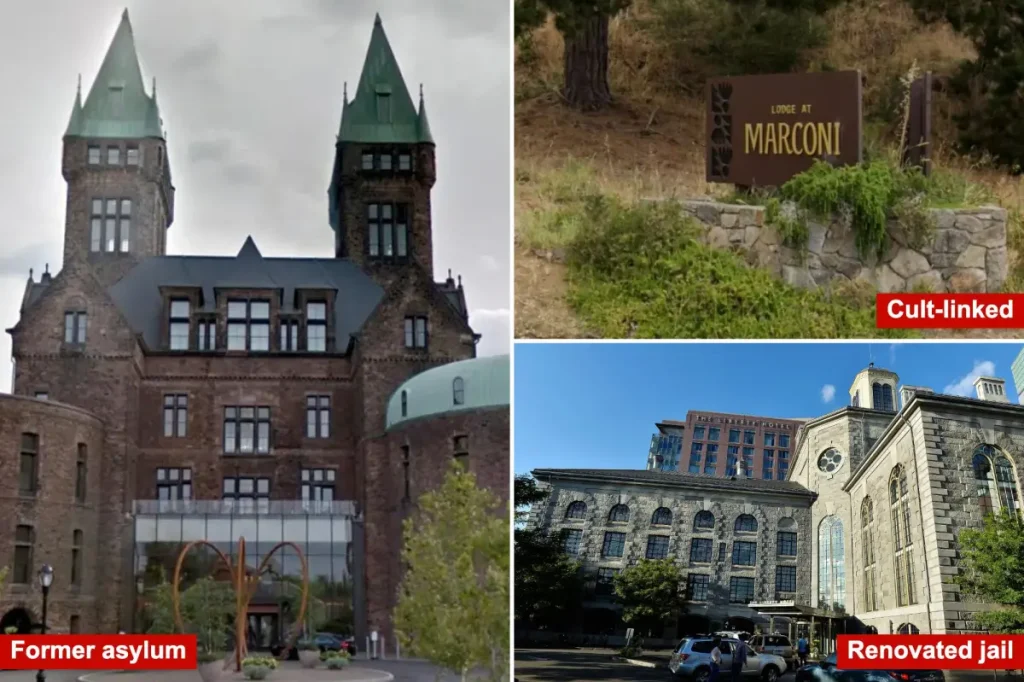America’s Hauntingly Transformed Hotels: From Notorious to Luxurious
Across America, a fascinating trend is breathing new life into historic buildings with dark pasts. Abandoned prisons, former asylums, and even cult headquarters are finding unexpected second acts as luxury accommodations. These transformations represent more than just practical repurposing—they reflect our cultural fascination with the macabre and mysterious. As modern travelers increasingly seek meaningful experiences over ordinary hotel stays, properties with complex histories are leveraging their unique stories to create immersive, unforgettable getaways. The New York Times recently highlighted this phenomenon, noting how these reimagined spaces attract everyone from paranormal enthusiasts to history buffs seeking connection with America’s shadowy past.
The Algonquin Hotel in Manhattan’s Times Square stands as a testament to New York’s literary golden age, once hosting the legendary Round Table gatherings of Jazz Age writers and wits like Dorothy Parker. Today, while maintaining its sophisticated charm, the hotel embraces whispers of paranormal activity—mysterious footsteps, unexplained flickering lights, and phantom conversations that seem to echo from a bygone era. In 2015, a curious journalist armed with ghost-hunting equipment reportedly made contact with eight spirits during an overnight stay. Whether you believe in the supernatural or simply appreciate literary history, the Algonquin offers an atmospheric experience starting at a surprisingly reasonable $177 per night. Similarly transformed is Oregon’s McMenamins Edgefield, a sprawling property outside Portland that now features a winery, brewery, distillery, spa, and golf course. Few guests might realize that in 1917, this picturesque retreat began as one of the nation’s first detention centers for women suspected of carrying sexually transmitted infections—a troubling chapter in America’s response to wartime health concerns. Later serving as a government “poor farm,” military academy, and eldercare facility, the property fell into disrepair before McMenamins resurrected it in 1990, beginning with a ceremonial cleansing ritual. Today, rooms range from $130 to $300, offering affordable access to this layered historical experience.
Perhaps no property leans more fully into its haunted reputation than Arkansas’ Crescent Hotel and Spa, widely promoted as “America’s most haunted hotel.” Perched dramatically on a mountaintop overlooking Eureka Springs, this Victorian landmark has accumulated tragic stories since its 1886 construction, when a stonemason fell to his death. Its darkest chapter unfolded in the 1930s under the ownership of Norman Baker, a notorious con man who transformed the building into a fraudulent cancer hospital. In the hotel basement, desperate patients underwent sham treatments while Baker systematically drained their families’ savings. Today, the Crescent embraces its spectral residents through popular ghost tours that wind through ornate Victorian corridors and into the former morgue. Guests paying between $150 and $600 per night might encounter reported apparitions including the ill-fated stonemason, former patients, or other restless spirits tied to the property. Wisconsin’s Pfister Hotel in Milwaukee presents a similar blend of luxury and legend. Built in 1893, this ornate establishment has cultivated such a powerful paranormal reputation that it regularly unnerves visiting Major League Baseball players in town to face the Brewers. Even Los Angeles Dodgers star Mookie Betts has publicly admitted being too spooked to stay there, while rapper Megan Thee Stallion has engaged in impromptu ghost hunting during her visits. Local lore suggests founder Charles Pfister himself still oversees his creation, manifesting through flickering lights, unexplained noises, and shadowy figures glimpsed in corridors.
The Richardson in upstate New York exemplifies how even the most troubling institutional spaces can be thoughtfully reimagined. Occupying part of the historic Richardson-Olmsted Campus—originally built in the late 1800s as the Buffalo State Asylum for the Insane—this hotel confronts the complex legacy of mental health treatment in America. During its operational years, the asylum became severely overcrowded and implemented controversial treatments including electroshock and insulin coma therapy. After decades of abandonment, during which paranormal investigators and urban explorers reported unsettling experiences in the former wards, a nonprofit board took on the massive preservation project. Today, the Richardson honors this difficult history while creating a space for celebration—hosting weddings, conferences, and cultural events with rooms starting at $169 per night. Montana’s Kimpton Armory Hotel in Bozeman represents a different kind of transformation, repurposing a 1941 National Guard armory into an Art Deco boutique hotel. The building’s military bones remain evident in its 18-inch-thick walls, former rifle range, and soundproof music room once used for military band practice. Reopened in 2020, the Armory balances historical preservation with luxury amenities including a rooftop pool and fitness center stocked with Peloton bikes, with accommodations ranging from $250 to $977 nightly.
Among the most dramatic reinventions is Boston’s Liberty Hotel, housed in the former Charles Street Jail—a formidable Gothic structure that operated from 1851 to 1990. The building’s cells once confined a remarkable cross-section of American history, including Boston Mayor James Michael Curley, anarchists Sacco and Vanzetti, civil rights leader Malcolm X, and notorious mobster Whitey Bulger. A $150 million conversion in 2007 transformed this imposing correctional facility into a luxury destination while preserving significant architectural elements. Today’s guests, paying from $590 per night, walk through the same massive atrium where prisoners once gathered, traverse original catwalks, and dine in restaurants playfully named “Clink” and “Alibi.” Perhaps most unusual is California’s Lodge at Marconi in Marin County, which began as a 1910s radio receiving station before becoming headquarters for Synanon—an organization that evolved from a drug rehabilitation program into a controversial cult known for weapons stockpiling and violent intimidation tactics. After the state acquired the property in 1984, incorporating it into Marconi State Historic Park, a multimillion-dollar renovation transformed the troubled space into a serene coastal retreat where rooms begin at $323. This wave of transformation reflects our complex relationship with difficult history—rather than erasing troubling pasts, these properties invite guests to engage with them, creating spaces that acknowledge darkness while cultivating beauty, comfort, and contemplation.



